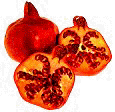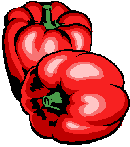
Also call:

 | DESCRIPTION
|
It is round like an orange with a hard calyx. The colour of the skin is leathery
red and it is thick. Inside this fruit, it is divided into large segments of walls, each
containing some large white seeds in small sack. The pulps are pinkish-red and it's juicy
sweet.
 | HISTORY AND ORIGIN
|
Pomegranates are originated in Persia. It is often called 'the apple with many
seeds.'
 | BUYING AND STORAGE
|
Choose large Pomegranates with rich colour that are heavy for their size. Look for
the glossy fruit. Avoid fruits that are shrivelled up.
Can be kept in room temperature for a few days until it splits open, which will tells
you the peak of ripeness but once ripe, must keep in the refrigerate for up to 1 week.
 | PREPARATION AND USE
|
Peel and section the fruit. Remove the seeds. Only the seeds are edible. It has a
sweet flavour. Can be added to fruit salads, fruit drinks, chicken, fish dishes. Can also be used as
a decorative fruit in flower arrangements.
 | NUTRITIONAL INFORMATION
|
It provides an excellent source of vitamin C.
 | MAJOR NUTRIENTS
|
- SERVING SIZE: 100 grm
| * ENERGY: |
278 kj |
* IRON: |
.5 mg
|
| * PROTEIN: |
2
grm |
* POTASSIUM: |
|
| * FAT: |
.2 grm |
* CALCIUM: |
|
| * CARBOHYDRATE: |
14
grm |
* VITAMIN A: |
|
| * DIETARY FIBRE: |
6 grm |
* VITAMIN B: |
|
| * SODIUM: |
4 grm |
* VITAMIN C: |
14
mg |
|




